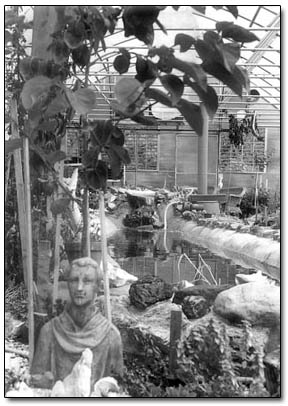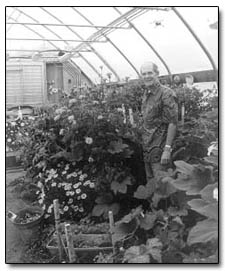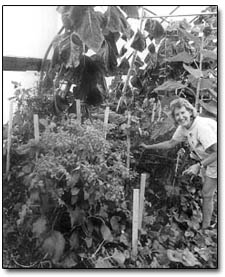|
Permacouple creates permaculture
written by Rachel Turiel
 |
This 2,200-square foot
greenhouse at Oakhaven Permaculture Center, in La
Plata Canyon, is owned by Christie Berven and Tom
Riesing. The center,
which also includes outdoor gardens, is founded on
the idea of creating a sustainable lifestyle by working
with nature./Courtesy photo |
In other times and places, Tom Riesing crunched numbers
on Wall Street, and Christie Berven taught elementary
school. Since meeting in 1998, the two have been born
again and are zealots for their cause: soil, earthworms,
beet greens. Tom and Christie are the creators of Oakhaven
Permaculture Center, tucked into the gamble oak and lichen-covered
rocks at 8,700 feet off La Plata Canyon Road. The center
consists of a 2,200-square-foot greenhouse, outdoor gardens,
ponds, chickens and the ever watchful, astonished gazes
of its creators.
Christie Berven is high energy, exuberance and fire.
She pins you with her eyes, talking so fast you hope she
remembers to breathe. If she is fire, Tom is stone, quarried
from a deep, still place in the earth. His movements are
slow and calculated, as are the thoughts he expresses.
At the ages of 56 and 65, respectively, Christie and Tom
are starting a new sort of family, and certainly a new
sort of life.
In their comfortable solar and wood-heated home, the
three of us sit on pillows and I ask them the obvious:
“What exactly is permaculture?” It seems I’ve
asked the right question because Christie leaps up to
retrieve the multicolored educational banners she’s
been working on. “This is my winter work,”
she says, gesturing to the first of four banners she’s
spread across the woodstove.
Words and phrases scripted in bubble paint jump out at
me: “nematodes,” “building the soil
from the ground up,” “cooperation not competition,”
“connection.” Christie begins reading the
words out loud, and they somehow sound like a prayer for
the earth.
When Christie is done with her chant, Tom explains in
his practical way that permaculture is an agricultural
movement. “It‘s a term coined by Bill Mollison,
of Tasmania, based on the phrase ‘permanent agriculture,’
and has come to encompass the idea of a sustainable culture
and economy through working with nature,” he says.
Catching the cue, Christie bolts from her position on
the pillow and like Vanna White replaces the current banner
with a new one that bears the heading “Permaculture.”
It is a simple banner. A circle on the inside holds the
word “ethics,” and radiating out are four
phrases: “Care of the earth”; “Care
of all beings”; “Share the surplus”;
and “Aware of the limitations of the earth.”
We start with the phrase “Care of the earth.”
“Have you ever seen a mountain meadow?” Christie
asks as she hops to her feet and points north, where indeed,
the La Plata Mountains cradle many such meadows. “There
is a synergistic relationship happening. Some plants are
taller than others, and those that need that protection
from the sun will grow near the taller plants. No one
Rototills; no one fertilizes; the leaves die in the fall
and cover the ground, protecting it from the sun and adding
nutrients. We study these natural systems so we can care
for and benefit from the earth with similar ease and efficiency,
making use of the natural connections.”
“If the soil dies, we die,” Tom adds from
his pillow, legs crossed and back straight as a board.
“Building the soil is caring for the earth.”
The permaculturist believes in working with the natural
elements and features of the land to produce more with
less work. If you’ve got a cold spot in your house
or on your land, create a root cellar. If you’ve
got a slope, grow moisture-loving plants at the bottom
where rainwater will collect. If you’ve got oak
trees where you want a garden, trim their limbs and use
them as strong trellises upon which to grow grapes, hops
and other fruitful vines. Leave the serviceberry shrubs,
they fix nitrogen in the soil.
 |
Tom Riesing,top, and Christie
Berven, bottom, pose among
the plants in their 2,200- square foot
greenhouse. The couple grows food
year-round in the greenhouse, using
rainwater and snowmelt to water the
plants. A pond, which collects heat
during the day, radiates heat at night
to keep the air above freezing./ Courtesy photos |
 |
| |
Part of permaculture is harnessing natural, free energy
and recycling it before it degrades. In this spirit Tom
and Christie collect rainwater and snow on the north side
of their 72-foot greenhouse, channeling it inside the
greenhouse where it warms up in a large pond and is used
to water their plants. Heat also is sacred, and every
bit possible is collected, stored and rereleased. During
the day, fans suck the hottest air from the ceiling of
the greenhouse, funneling it into the soil where it blows
through 4,000 feet of slotted pipe in 150 yards of crushed
rock and sand and radiates back into the greenhouse at
night when the plants need it most.
Working too hard, against the flow of nature, is discouraged.
Any tilling that takes place is done by earthworms, chickens,
ants and snakes, all of which are welcome in the greenhouse
and outdoor garden spaces at Oakhaven. To prepare a new
bed in fall, they lay down cardboard “which the
earthworms love to eat,” then 6 inches of manure
and a thick layer of straw to top it off. Then the rains
and snow come, helping to break down the compost sandwich
and keep the worms hydrated. By spring, all the work is
done and they’re left with almost a foot of excellent
planting medium. Not only does tilling soil require unneeded
work, and often fossil fuels and money, it can break up
the roots of weeds, creating many more unwanted plants.
Tilling also destroys the network of fungal mycelia (mushroom
roots) which helps hold moisture in the soil and can have
a beneficial relationship with many roots of perennials.
And most of all, this is how the wild garden is built
by nature, from the ground up.
Tom talks about farming practices in California where
tremendous acres of strawberries are grown. “First
they spray the land with methyl bromide, killing everything.
Then they add fertilizer to support life.”
“It’s ass backwards!” Christie exclaims,
“They’re killing the insects, fungi and microscopic
organisms that naturally build and fertilize the soil.
Plus it’s too much work.”
A principle of permaculture design is to produce more
than what you put in, as well as save time, money and
space by having each element of your agricultural design
perform at least three functions. For Tom and Christie,
their greenhouse pond illustrates this ideal. In addition
to absorbing heat during the day and radiating it at night,
the 5,000-gallon tank holds water for plants and provides
humidity. “There’s so much moisture in here
in the morning you need an umbrella,” Christie says.
The bonus feature is the algae that grows in the pond;
it is scooped out and given to the plants as fertilizer.
After coming up to speed on the basics, the moment I’ve
been waiting for arrives. It’s time to visit the
greenhouse.
In the middle of winter this greenhouse, which is bigger
than the house I share with four adults, is like a temperate
coastal farm. Fragrant nicotiana flowers grow taller than
my head, plump figs
droop from limbs and a thigh-high mound of calendula with
sand dollar-sized blossoms seem to wave hello with their
yellow and orange heads.
“Fairies live here,” Christie announces matter-of-factly.
Tom plucks dill, arugula and beet greens for me to sample.
The greenhouse was built by Tom and Christie and a motley,
generous crew of FLC students and friends. It is heated
at night, though to no warmer than 40 degrees Fahrenheit.
Despite the chilly evening temperatures, tomatoes and
chili peppers are steadily turning from green to red.
Christie points out how the tomatoes grow in winter: low
to the ground to conserve heat. “The plants are
brilliant – they adapt!” she trills. Christie
recently cut back “a sea of medicinal borage flowers,”
though often when plants get crowded she stands back and
commands “you guys work it out.”
Although most of what they grow is for personal consumption,
Tom and Christie do sell or trade for some of their produce.
For example, last year they sold 85 pounds of pumpkins
to Durango Natural Foods, and occasionally they sell items
to the Kennebec Cafe, down the road.
As far as the future goes, Tom and Christie have big
plans. They’d like to grow mushrooms in part of
the greenhouse pond. They want to build a permaculture
center on their property for classes and workshops on
permaculture design, and sustainable building, eating
and living.
As the tour ends, I ask the ever expressive Christie
for any final words.
She grins and grabs Tom by the arm. “We’re
a permacouple, Tommy and me, and all we need is lovage.”
n
For more information on upcoming
classes at Oakhaven, call 259-5445.
|

